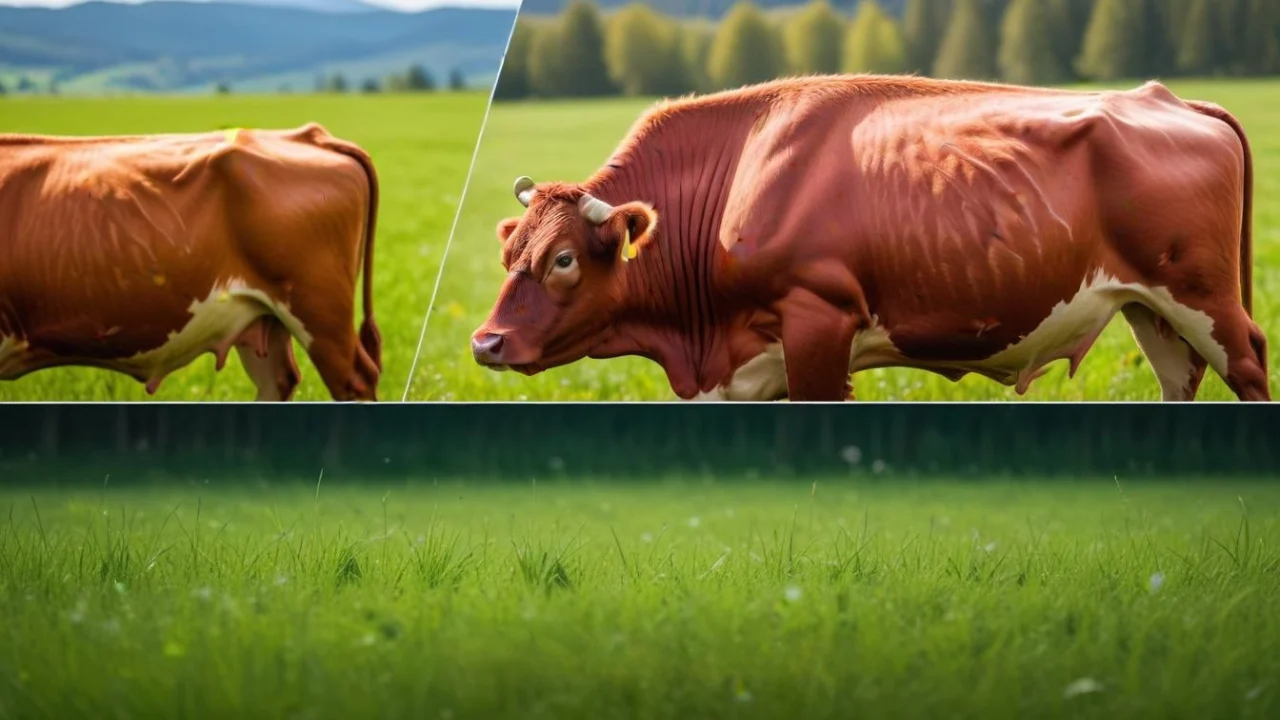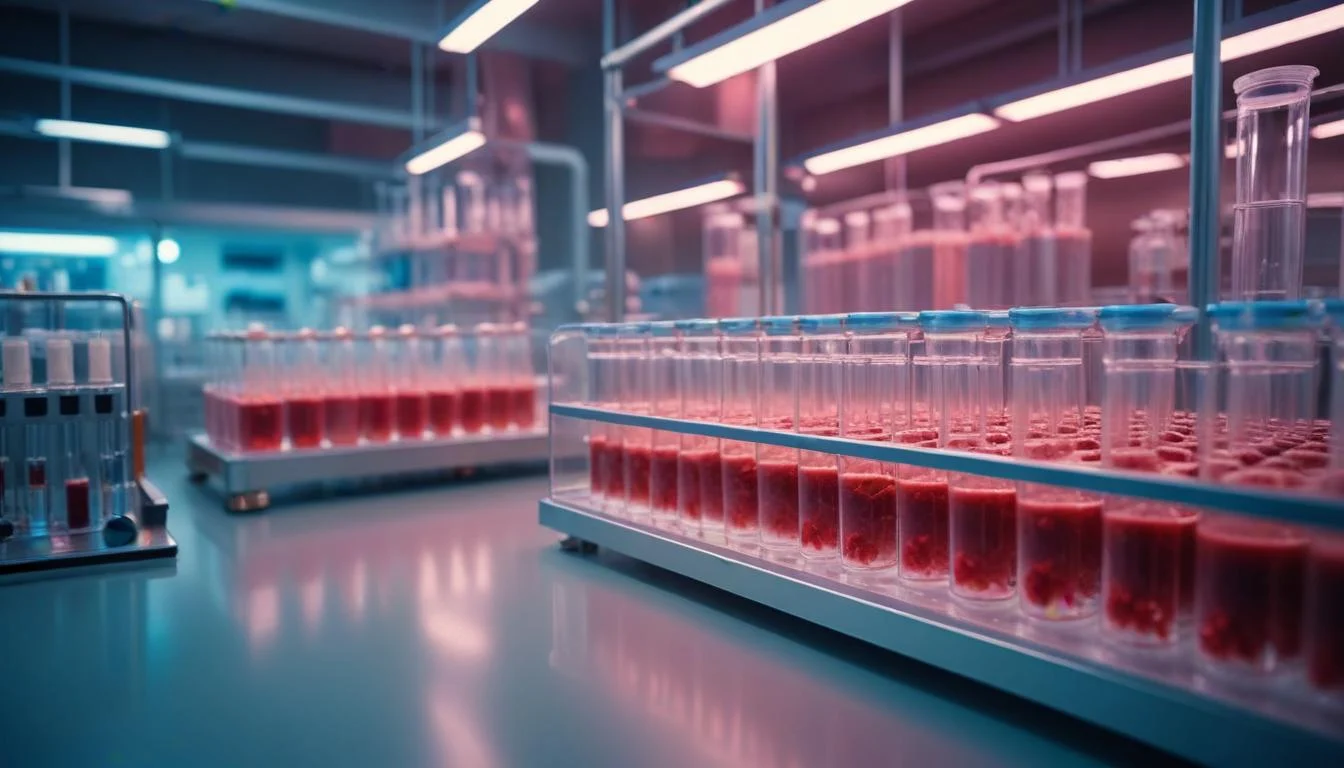 🔔 Affiliate Disclosure
This content may contain affiliate links. If you click on a link and make a purchase, we may receive a small commission — at no extra cost to you. Thank you for supporting BeatInsights! 💛
🔔 Affiliate Disclosure
This content may contain affiliate links. If you click on a link and make a purchase, we may receive a small commission — at no extra cost to you. Thank you for supporting BeatInsights! 💛
Nearly 10 billion animals are killed for food each year in the US. This has vast consequences. Enter lab-grown meat. It is also known as cultured meat or cell-based meat. It uses animal cells to grow meat in a lab. There is growing interest. Investment in this tech is rising. Lab-grown meat offers many Lab-grown Meat Benefits. These Cultured meat environmental impact gains address ethics. There are also possible health issues with normal meat. This tech might solve those. It can address concerns of Ethical considerations of cell-based meat, and the potential for Lab-grown meat nutritional advantages. It also has promise for Cellular agriculture sustainability. Lab-grown meat is a solution.
Environmental Lab-grown Meat Benefits
The Cultured meat environmental impact is vast. This is a main reason for its rising popularity. Traditional meat production is hard on the Earth. Lab-grown meat has the potential to reduce this harm.
Reduced Greenhouse Gas Emissions
Traditional livestock farming creates a lot of greenhouse gases. This contributes to climate change. Cows produce methane. This is a powerful greenhouse gas. Lab-grown meat production could emit fewer gases. This can create a smaller carbon footprint. A study by the University of Oxford, available via Oxford Martin School, suggests lab-grown meat could significantly reduce emissions. More data is needed, however.
Lower Land Usage
Raising livestock needs a lot of land. This land is for grazing. It is also for growing feed. Lab-grown meat needs much less land. It is grown in labs, so it does not need pastures. This can free up land for other uses. It could help restore forests. It also helps wildlife.
Water Conservation
Water is used in farming. This includes raising livestock. It is also used to grow their food. Lab-grown meat needs less water. The process is more efficient. This can help save water. Especially in areas with water shortages. A report by the Environmental Science & Technology journal supports this.

Decreased Pollution
Animal agriculture causes pollution. Fertilizer runoff pollutes water. Waste from animals creates problems. Lab-grown meat reduces these problems. It minimizes fertilizer use. It also reduces waste issues. This makes it more eco-friendly.
Ethical Considerations and Animal Welfare
One of the main Lab-grown Meat Benefits is ethical. Many people have concerns about how animals are treated. Traditional meat production involves raising and slaughtering animals.
Eliminating Animal Suffering
Lab-grown meat eliminates the need to raise animals for food. This avoids animal suffering. Animals don’t have to live in poor conditions. They are not slaughtered. This appeals to people who care about animal welfare.
Reducing the Risk of Zoonotic Diseases
Diseases can spread from animals to humans. This is called zoonotic disease. Animal farms can be breeding grounds for these diseases. Lab-grown meat can lower this risk. It grows in a controlled environment. This reduces the chance of disease spread. The CDC provides info on zoonotic diseases.
Improved Farmworker Conditions
Slaughterhouses can be dangerous places to work. The jobs are hard. Conditions can be poor. Lab-grown meat facilities could offer safer jobs. These labs could create more ethical work environments. This could be a benefit for workers.
Ethical Concerns Addressed
Some have ethical concerns about lab-grown meat. These concerns include cell sourcing. They are also related to ownership. Where do the cells come from? Who owns the technology? These are important questions. Companies can address these. They can be transparent. They can source cells ethically. Laws can ensure fair ownership. This addresses concerns.
Potential Health and Lab-grown Meat Benefits
Besides ethical and environmental gains, lab-grown meat can have health benefits. Lab-grown meat nutritional advantages are a key aspect to consider.
Customizable Nutritional Profile
Lab-grown meat can be altered. It can be engineered to have specific nutrients. For example, it could have less saturated fat. It could have more omega-3 fatty acids. This can make it healthier than normal meat. It could help people with certain health needs.

Reduced Risk of Foodborne Illness
Normal meat can carry diseases. These cause food poisoning. Lab-grown meat is made in a clean place. This lowers the risk of illness. The process is controlled. This reduces exposure to pathogens. This means safer meat. For more on food safety, check out the USDA’s website: USDA Food Safety.
Lab-grown meat presents a novel approach to food production. This method aims to address concerns about environmental impact and food security. Benefits such as reduced land use and lower greenhouse gas emissions are often cited. This technology also has potential ethical advantages. Cultured meat environmental impact could be significant. Cellular agriculture sustainability could revolutionize food systems. Lab-grown meat nutritional advantages can address specific dietary needs. Ethical considerations of cell-based meat also play a crucial role. The various Lab-grown Meat Benefits include food safety through controlled production.
Lab-Grown Meat and Food Safety
Lab-grown meat offers enhanced food safety through its controlled production process. Traditional meat production faces risks of contamination. Harmful bacteria such as E. coli and Salmonella can pose serious health threats. However, lab-grown meat minimizes these risks. The controlled environment reduces exposure to these pathogens.

The process starts with a small sample of animal cells. These cells are then grown in a sterile bioreactor. This closed system prevents external contamination. In contrast, conventional farming has several contamination points. These points include animal handling and slaughtering. Therefore, lab-grown meat has a safety advantage.
Elimination of Antibiotic Use
Another key advantage is the elimination of antibiotic use. In traditional animal agriculture, antibiotics are often used routinely. This helps prevent disease and promote growth. However, it contributes to antibiotic resistance. Antibiotic resistance is a major global health concern.
Lab-grown meat doesn’t require antibiotics. The sterile environment minimizes the risk of infection. As a result, this reduces the need for such preventative measures. This can help combat the growing problem of antibiotic resistance. Lab-grown meat offers a more responsible approach to food production. It lessens the reliance on antibiotics.
Potential for Allergen Removal
Lab-grown meat holds the potential to remove common allergens. Many people have allergies to meat products. These allergies can range from mild to severe. Common allergens include specific proteins found in animal muscle. Therefore, modifying the cellular structure is an option.
Cellular agriculture allows for precise control over the composition of meat. Scientists can potentially remove or alter allergenic proteins. This makes lab-grown meat accessible to a wider range of consumers. People with allergies could finally enjoy meat safely. Research into allergen removal is still ongoing. However, the potential is promising.
Addressing Challenges and Obstacles
Despite its potential, lab-grown meat faces several challenges. These challenges must be addressed for widespread adoption. Cost, scalability, consumer acceptance and regulatory hurdles are all critical.
Cost and Scalability
One major hurdle is the current high cost of production. The process of growing meat in a lab is still expensive. It requires specialized equipment and highly skilled personnel. Scaling up production to meet consumer demand is also a challenge. Current facilities are not capable of producing large quantities.
However, technological advancements are helping reduce costs. Researchers are working on more efficient production methods. They explore ways to grow cells more quickly and cheaply. Investment in infrastructure is also crucial. More funding can increase production capacity. Despite the current challenges, there’s hope. Lower costs and greater scale are possible.
Consumer Acceptance
Consumer acceptance is another significant barrier. Some people are skeptical about lab-grown meat. They have concerns about its safety and taste. Others worry about the ethics of consuming artificial meat. These concerns need to be addressed through education and transparency.
Providing clear information about the production process is vital. Demonstrating the safety and nutritional value of lab-grown meat is also key. Taste tests and product demonstrations can help change perceptions. Building trust with consumers is essential for acceptance. Ethical considerations of cell-based meat are important.
Regulatory Hurdles
Bringing lab-grown meat to market involves regulatory hurdles. Governments around the world are developing regulations. These regulations cover labeling, safety approvals, and production standards. Navigating this regulatory landscape can be complex. Clear and consistent regulations are needed to ensure a fair and safe market. The FDA and USDA are actively involved in this process in the US.
Public Perception and Trust
Public perception significantly impacts acceptance. Marketing and education are crucial. They play a key role in building trust. Effectively communicating the benefits is vital. This includes highlighting reduced environmental impact. Lab-grown meat offers a sustainable alternative. Transparently addressing concerns and misconceptions is necessary. Building public trust is essential for success. The Lab-grown Meat Benefits should be highlighted.
The Future of Lab-Grown Meat
The future of lab-grown meat looks promising. Market projections indicate significant growth potential. Technological advancements are also driving progress. Collaboration and partnerships will be essential. This effort should create a sustainable food system.
Market Projections and Growth Potential
The lab-grown meat market is projected to grow rapidly. Several reports forecast significant expansion in the coming years. Factors driving this growth include rising demand for meat alternatives. Also, increasing awareness of environmental issues is a driver. Investor interest in cellular agriculture is growing. This influx of capital will fuel innovation and expansion. The expected growth varies. However, the overall trend points to a substantial market.
Technological Advancements
Ongoing research is improving lab-grown meat. Efforts focus on taste, texture, and cost-effectiveness. Scientists are exploring new cell lines and growth mediums. They are also developing more efficient bioreactors. Advances in tissue engineering are also contributing. These advancements will make lab-grown meat more appealing. They will also reduce the cost of production. The lab-grown meat nutritional advantages are continually being explored.
Collaboration and Partnerships
Collaboration is crucial for advancing the field. Partnerships between scientists, investors, and policymakers are essential. Scientists bring expertise in cell biology and tissue engineering. Investors provide funding and business acumen. Policymakers create regulatory frameworks. These collaborations accelerate innovation. They ensure responsible development and commercialization. Lab-grown Meat Benefits from this collaboration.
Lab-Grown Meat and Sustainable Food Systems
Lab-grown meat fits within a broader context. It promotes a sustainable and resilient food system. Traditional agriculture faces many challenges. These include climate change and resource depletion. Lab-grown meat offers a more sustainable alternative. It reduces land use, water consumption, and greenhouse gas emissions. By adopting this technology, we can create a more secure food system. Cellular agriculture sustainability is an important goal. Cultured meat environmental impact can be considerable.
Conclusion
Lab-grown meat offers many benefits. It reduces environmental impact. It also improves food safety and animal welfare. This technology has the potential to revolutionize the food industry. Learn more about lab-grown meat by visiting The Good Food Institute.
Consider supporting the development of lab-grown meat. The future of food may depend on it. Ethical considerations of cell-based meat will shape its future. Together, we can create a more sustainable food system. Let’s embrace this innovation for a better tomorrow.




